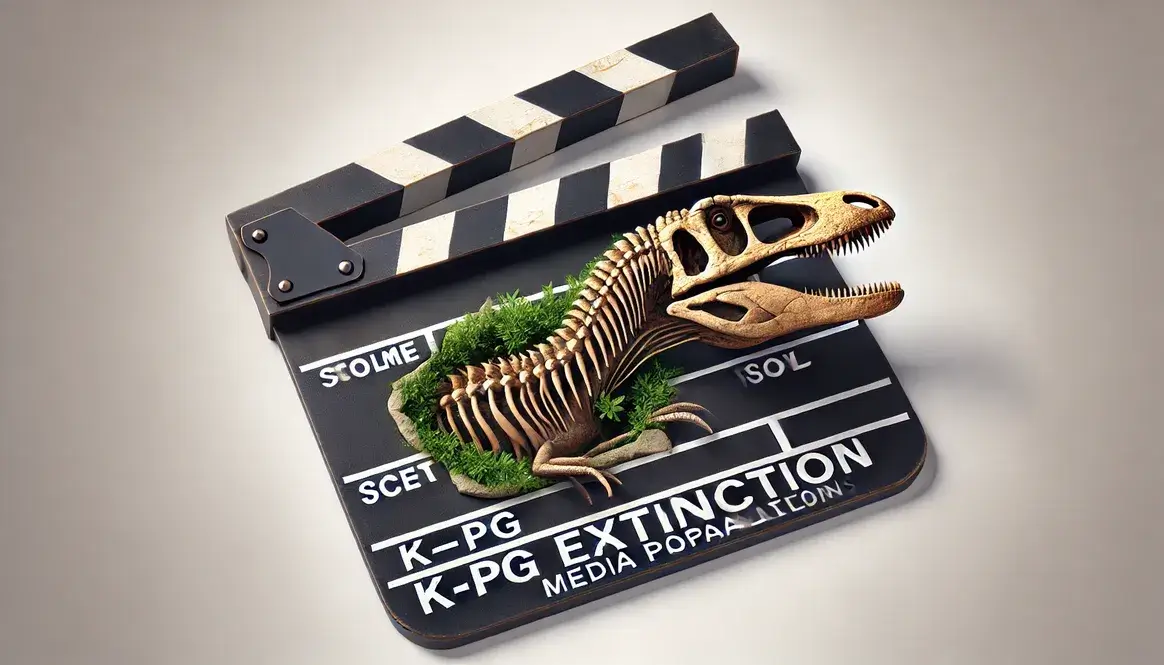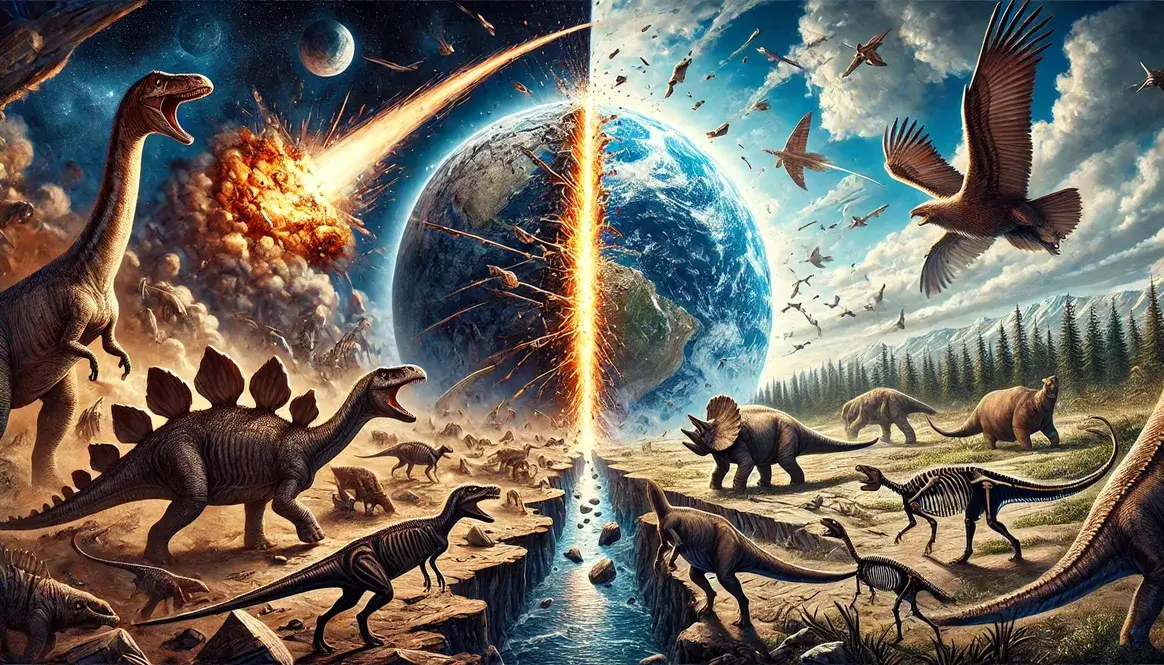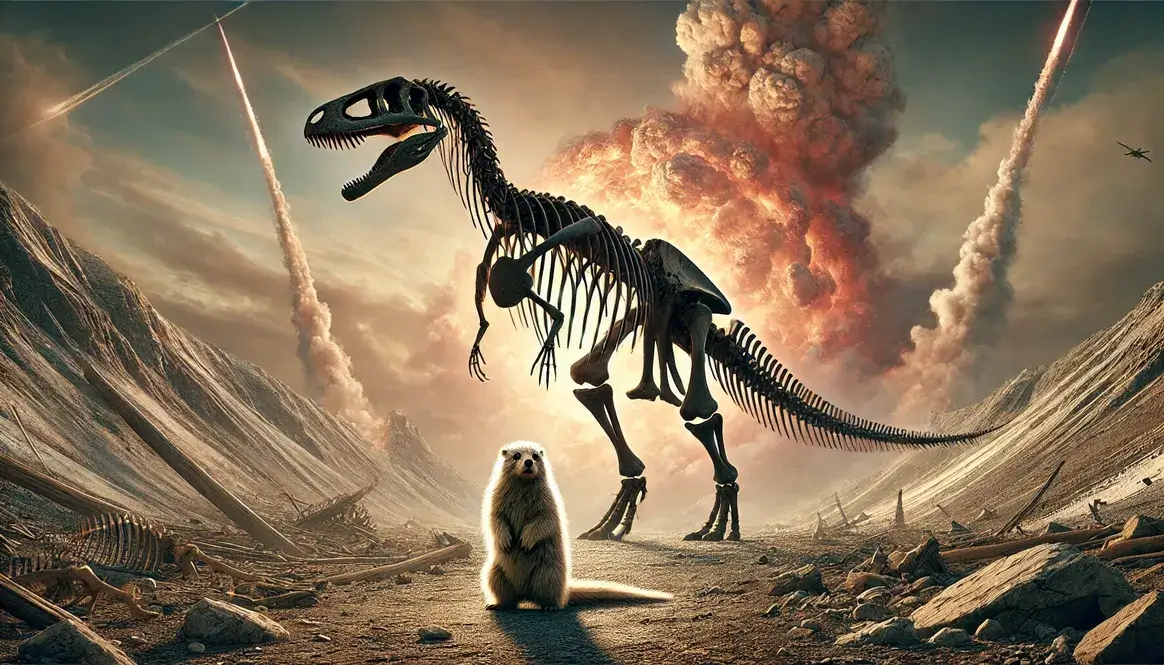The K-Pg Extinction Event: A Brief Refresher
The K-Pg extinction event, which occurred about 66 million years ago, marks one of the most significant moments in Earth’s history. This cataclysmic event wiped out approximately 75% of plant and animal species on our planet, including the non-avian dinosaurs.
Scientists believe a massive asteroid impact was the main culprit behind this mass extinction. The collision caused global climate changes, including widespread fires, darkness, and rapid cooling followed by long-term warming. These drastic environmental shifts proved too much for many species to handle.
The K-Pg extinction event (formerly known as the K-T extinction) gets its name from the boundary between the Cretaceous (K) and Paleogene (Pg) periods in the geological timescale. This boundary is visible in rock layers around the world, often marked by a thin layer of clay rich in iridium, an element rare on Earth but common in asteroids.
For more details on the science behind this extinction event, check out our article on the Cretaceous-Paleogene extinction event explained.
K-Pg Extinction in Movies and Books: An Overview
The K-Pg extinction event has captured the imagination of filmmakers, authors, and audiences alike. It’s not hard to see why – the idea of a world-ending catastrophe that wiped out some of the most impressive creatures ever to walk the Earth is both terrifying and fascinating.
Movies and books featuring the K-Pg extinction often use it as a dramatic backdrop for stories about survival, the power of nature, and the fragility of life. Some focus on the extinction itself, while others use it as a starting point for “what if” scenarios or as a cautionary tale about current environmental issues.
The significance of the K-Pg extinction in popular media goes beyond mere entertainment. These portrayals shape public understanding of this crucial event in Earth’s history. They can spark interest in paleontology and earth sciences, encouraging viewers and readers to learn more about our planet’s past.
However, the line between scientific fact and dramatic fiction can sometimes blur in these portrayals. While some works strive for accuracy, others take creative liberties for the sake of storytelling. This mix of fact and fiction in popular media has a significant impact on how people perceive the K-Pg extinction event and its consequences.
In the following sections, we’ll explore how movies and books have depicted the K-Pg extinction, examining both fictional and non-fictional works. We’ll also look at the accuracy of these portrayals and their impact on public understanding of this pivotal moment in Earth’s history.
Notable Movies Featuring the K-Pg Extinction
The K-Pg extinction event has been a popular subject in cinema, appearing in both blockbuster films and educational documentaries. Let’s explore how these different types of movies have portrayed this world-changing event.
Blockbuster Films
Hollywood has long been fascinated by the dramatic potential of the K-Pg extinction. Here are some notable examples:
- Jurassic Park (1993): While not directly about the extinction event, this Steven Spielberg classic popularized dinosaurs and briefly touched on extinction theories. It sparked a renewed interest in paleontology among the general public.
- Deep Impact (1998): This disaster film depicts a comet collision with Earth, drawing parallels to the K-Pg asteroid impact. The movie showcases the global consequences of such an event, though with a more modern setting.
- Dinosaur (2000): Disney’s animated feature begins with the K-Pg asteroid impact, showing its immediate effects on dinosaur habitats. While scientifically inaccurate in many aspects, it vividly illustrates the chaos of the event.
These blockbusters often prioritize spectacle over scientific accuracy. They typically depict the extinction as a sudden, dramatic event, with less focus on the long-term environmental changes that followed. While this approach creates exciting cinema, it can lead to misconceptions about the actual extinction process.
Documentary Films
Documentaries strive for a more accurate portrayal of the K-Pg extinction. Here’s a comparison of how they differ from fictional films:
| Aspect | Documentaries | Fictional Films |
|---|---|---|
| Focus | Scientific evidence and theories | Dramatic narrative and visual effects |
| Timescale | Covers long-term effects | Often shows only immediate impact |
| Accuracy | Strives for current scientific consensus | May sacrifice accuracy for story |
| Scope | Explores various extinction theories | Usually focuses on asteroid impact |
Some notable documentaries include:
- “Last Day of the Dinosaurs” (2010): This documentary uses CGI to recreate the extinction event, balancing scientific accuracy with visual storytelling.
- “Mass Extinction: Life at the Brink” (2014): This film explores the K-Pg extinction alongside other mass extinctions, providing a broader context.
- “Nova: Day the Dinosaurs Died” (2017): This PBS documentary follows scientists as they drill into the Chicxulub crater, offering viewers an up-close look at extinction research.
Documentaries generally provide a more nuanced view of the extinction event. They often discuss multiple factors contributing to the mass die-off, including the long-term climate changes that followed the initial impact. This approach gives viewers a more comprehensive understanding of the event’s complexity.
While fictional films might inspire wonder and curiosity about dinosaurs and their extinction, documentaries are crucial for providing accurate information. They play a vital role in correcting misconceptions that might arise from more dramatized portrayals.
K-Pg Extinction in Literature
The K-Pg extinction event has been a fertile ground for both non-fiction and fiction authors. Let’s explore how this pivotal moment in Earth’s history has been portrayed in various forms of literature.
Non-Fiction Books
Non-fiction books about the K-Pg extinction cater to a wide range of readers, from science enthusiasts to casual learners. These works often combine scientific rigor with engaging storytelling to make complex concepts accessible to general audiences.
Some notable non-fiction books include:
- “The Dinosaur Heresies” by Robert T. Bakker (1986)
- Challenged traditional views of dinosaurs
- Discussed new theories about dinosaur extinction
- “T. rex and the Crater of Doom” by Walter Alvarez (1997)
- Written by the scientist who proposed the asteroid impact theory
- Provides a firsthand account of the scientific discovery process
- “The Ends of the World” by Peter Brannen (2017)
- Explores the K-Pg extinction in the context of other mass extinctions
- Draws parallels to current climate change issues
These books often delve into the detective work involved in piecing together the extinction puzzle. They highlight how scientists use evidence from fossil records and geological formations to reconstruct events that occurred millions of years ago.
Popular science books on this topic typically cover:
- The evolution of extinction theories over time
- Detailed explanations of the impact hypothesis
- Descriptions of the Chicxulub crater and its discovery
- Discussions about animals that survived the extinction event
Fiction Books
Fictional works have also embraced the K-Pg extinction, using it as a backdrop for various storytelling purposes. Authors have found creative ways to incorporate this event into their narratives, often blending scientific facts with imaginative scenarios.
Here’s how some authors have used the K-Pg extinction in their storytelling:
| Usage | Example | Description |
|---|---|---|
| Historical Fiction | “The Evolution of Claire” by Tess Sharpe | Set in the Jurassic World universe, touches on extinction theories |
| Time Travel | “Bones of the Earth” by Michael Swanwick | Scientists travel back in time to study dinosaurs before the extinction |
| Alternate History | “West of Eden” by Harry Harrison | Imagines a world where the extinction didn’t happen |
| Cli-Fi (Climate Fiction) | “The Drowned World” by J.G. Ballard | Uses past extinctions as a parallel to potential future climate catastrophes |
These works of fiction often use the K-Pg extinction to explore themes such as:
- The fragility of life and ecosystems
- Humanity’s relationship with nature
- The consequences of catastrophic events
- The resilience and adaptability of life
While fictional books may take liberties with scientific facts, they play a crucial role in sparking interest in paleontology and earth sciences. They can inspire readers to learn more about the actual events and the fascinating creatures that once roamed our planet.
By blending fact and fiction, these novels create compelling narratives that bring the distant past to life, making the K-Pg extinction event more tangible and relatable to modern readers.
Accuracy in K-Pg Extinction Portrayals
When it comes to depicting the K-Pg extinction in movies and books, the line between scientific fact and artistic license can often blur. Let’s explore some common misconceptions and highlight examples of more accurate portrayals.
Common Misconceptions
Media representations of the K-Pg extinction often include inaccuracies for the sake of drama or simplification. Here are some frequent misconceptions and the scientific reality behind them:
- Instant Extinction Myth
- Misconception: All dinosaurs died immediately after the asteroid impact.
- Reality: The extinction process likely took thousands of years. While the initial impact was catastrophic, many species survived the immediate aftermath only to succumb to long-term environmental changes.
- Dinosaur Diversity Error
- Misconception: All dinosaurs lived together at the same time.
- Reality: Dinosaurs existed for over 165 million years, with different species evolving and going extinct throughout this period. The dinosaur timeline was much more complex than often portrayed.
- Volcano vs. Asteroid Debate
- Misconception: It was either an asteroid or volcanoes that caused the extinction.
- Reality: Current evidence suggests a combination of factors, with the asteroid impact likely triggering or exacerbating volcanic activity in the Deccan Traps.
- Uniform Global Impact
- Misconception: The extinction affected all regions equally.
- Reality: The impact had varying effects in different parts of the world. Some areas, like the Arctic regions, may have been less severely affected.
- T. Rex Prominence
- Misconception: T. Rex was the dominant dinosaur everywhere.
- Reality: While T. Rex was a formidable predator, it was just one of many theropod species and was limited to North America.
Scientifically Accurate Depictions
Despite these common misconceptions, some works have managed to portray the K-Pg extinction with impressive accuracy. Here are a few examples:
- “The Day the Mesozoic Died” (2012) This short film by Howard Hughes Medical Institute strikes a balance between scientific accuracy and engaging storytelling. It follows the scientific process that led to the asteroid impact theory, providing an excellent educational resource.
- “The Last Day of the Cretaceous” by Rick Gore (National Geographic, 1978) This article, while older, set a high standard for accurate science communication about the K-Pg extinction. It presents multiple hypotheses and explains the evidence for each, reflecting the scientific uncertainty of the time.
- “A Short History of Nearly Everything” by Bill Bryson (2003) In his chapter on extinctions, Bryson provides an entertaining yet accurate account of the K-Pg event, explaining complex scientific concepts in accessible language.
These works succeed in balancing entertainment and education by:
- Using vivid language and imagery to make scientific concepts engaging
- Presenting multiple viewpoints to reflect scientific debate
- Clearly distinguishing between established facts and speculative ideas
- Employing analogies to help readers understand complex processes
- Focusing on the human side of scientific discovery to create narrative interest
By adhering closely to scientific evidence while still crafting compelling narratives, these works demonstrate that accuracy and entertainment are not mutually exclusive. They show that the true story of the K-Pg extinction, with all its complexity and uncertainty, can be just as fascinating as any fictionalized account.
Impact on Public Understanding
The portrayal of the K-Pg extinction in movies and books has significantly influenced public perception of this crucial event in Earth’s history. Let’s explore how these media representations shape our understanding and their educational value.
Shaping Public Perception
Movies and books play a pivotal role in forming the public’s understanding of scientific concepts, including the K-Pg extinction. Here’s how they influence people’s perceptions:
- Visualization of Abstract Concepts: Media helps people visualize complex ideas like the global climate changes that followed the asteroid impact.
- Emotional Connection: By creating narratives around scientific events, media helps viewers and readers form emotional connections to prehistoric life and extinction events.
- Simplification of Complex Ideas: While this can lead to misconceptions, it also makes scientific concepts more accessible to the general public.
- Cultural References: Popular depictions create shared cultural references that shape how society thinks about dinosaurs and their extinction.
The “Jurassic Park Effect” on paleontology is a prime example of media influence. This phenomenon refers to the surge in public interest and funding for paleontology following the release of the Jurassic Park franchise. While the movies took many creative liberties, they also:
- Sparked widespread fascination with dinosaurs
- Introduced the public to concepts like DNA preservation
- Popularized debates about dinosaur behavior and intelligence
However, the Jurassic Park effect also led to some misconceptions, such as the idea that all dinosaurs were enormous or that velociraptors were much larger than their actual size.
Educational Value
The portrayal of the K-Pg extinction in popular media has both positive and negative impacts on public science education.
Positive Impacts:
- Increased Interest: Media depictions often spark curiosity about paleontology and earth sciences.
- Gateway to Learning: Popular books and movies can serve as entry points for deeper scientific exploration.
- Funding Boost: Increased public interest can lead to more funding for paleontological research.
- Simplified Explanations: Media can make complex scientific concepts more understandable to the general public.
Potential Drawbacks:
| Drawback | Description | Example |
|---|---|---|
| Oversimplification | Complex events are often reduced to simple narratives | Portraying the extinction as an instantaneous event |
| Sensationalism | Exaggeration for dramatic effect | Depicting all dinosaurs as enormous and aggressive |
| Outdated Information | Media may perpetuate old theories | Showing dinosaurs as slow, cold-blooded creatures |
| Focus on Spectacle | Emphasis on visual impact over scientific accuracy | Portraying unrealistic dinosaur behaviors for dramatic effect |
Despite these drawbacks, the overall impact of media portrayals on public understanding of the K-Pg extinction has been largely positive. They have brought this pivotal moment in Earth’s history into the public consciousness, encouraging people to learn more about prehistoric life and the processes that shape our planet.
The key lies in using these popular depictions as starting points for further education. By combining the engaging narratives of movies and books with accurate scientific information, we can foster a more nuanced and accurate public understanding of the K-Pg extinction event and its significance in Earth’s history.
Evolution of K-Pg Extinction Portrayals Over Time
The way movies and books have depicted the K-Pg extinction has changed dramatically over the years, reflecting both advances in scientific understanding and shifts in popular culture. Let’s take a chronological look at how these portrayals have evolved.
1960s-1970s: The Age of Speculation
In this era, the cause of dinosaur extinction was still a mystery. Media portrayals often reflected this uncertainty:
- Books like “The Great Dinosaur Mystery” (1960) by Mary Adrian explored various extinction theories, including climate change and disease.
- The focus was often on the mystery itself rather than specific extinction scenarios.
1980s: The Impact Hypothesis Emerges
The 1980s saw a significant shift in both scientific understanding and media portrayals:
- 1980: Luis Alvarez and colleagues published their groundbreaking paper proposing the asteroid impact theory.
- Media quickly latched onto this dramatic new idea:
- Documentaries like “The Night the Dinosaurs Died” (1985) began exploring the impact hypothesis.
- Fiction started incorporating asteroid impacts, though not always accurately.
1990s: Dinosaur Renaissance in Media
The 1990s marked a turning point in how the K-Pg extinction was portrayed:
- “Jurassic Park” (1993) revolutionized dinosaur depictions, showing them as active, intelligent creatures.
- While not focusing on the extinction itself, it sparked public interest in paleontology.
- Documentaries became more sophisticated, using CGI to recreate extinction scenarios.
2000s: Refining the Narrative
As scientific understanding deepened, media portrayals became more nuanced:
| Decade | Scientific Developments | Media Portrayals |
|---|---|---|
| 2000s | Discovery of the Chicxulub crater | More accurate depictions of the impact site |
| Evidence for prolonged extinction | Shift from “instant death” to extended process | |
| Role of volcanism explored | Inclusion of multiple factors in extinction narratives |
2010s-Present: Multifaceted Approach
Recent years have seen increasingly sophisticated portrayals:
- Incorporation of latest research:
- Media now often includes discussions of marine ecosystem collapse and long-term climate effects.
- Documentaries like “Nova: Day the Dinosaurs Died” (2017) show real-time scientific investigations.
- Focus on survivors:
- Increased attention to animals that survived the extinction, not just those that perished.
- Exploration of how the extinction shaped modern biodiversity.
- Climate change parallels:
- Many recent works draw parallels between the K-Pg extinction and current climate issues.
- This approach adds relevance and urgency to prehistoric events.
Throughout this evolution, scientific discoveries have played a crucial role in shaping media representations. Each major finding, from the identification of the iridium layer to the mapping of the Chicxulub crater, has found its way into books, movies, and documentaries, often within years of the initial discovery.
This rapid incorporation of new science into popular media has both benefits and drawbacks. While it keeps public interest high and spreads new knowledge quickly, it can also lead to the propagation of preliminary findings before they’re fully verified.
As our understanding of the K-Pg extinction continues to evolve, we can expect media portrayals to keep pace, offering ever more accurate and nuanced depictions of this pivotal moment in Earth’s history.









